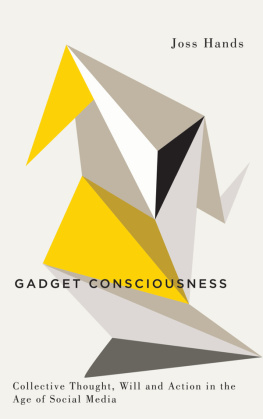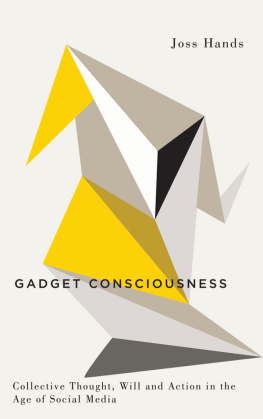Contents
Guide
Gadget Consciousness
Digital Barricades:
Interventions in Digital Culture and Politics
Series editors:
Professor Jodi Dean, Hobart and William Smith Colleges Dr Joss Hands, Newcastle University Professor Tim Jordan, University of Sussex
Also available:
Shooting a Revolution:
Visual Media and Warfare in Syria
Donatella Della Ratta
Cyber-Proletariat:
Global Labour in the Digital Vortex
Nick Dyer-Witheford
The Digital Party:
Political Organisation and Online Democracy
Paolo Gerbaudo
Information Politics:
Liberation and Exploitation in the Digital Society
Tim Jordan
Unreal Objects:
Digital Materialities, Technoscientific Projects and Political Realities
Kate ORiordan
Gadget Consciousness
Collective Thought, Will and Action in the Age of Social Media
Joss Hands

First published 2019 by Pluto Press
345 Archway Road, London N6 5AA
www.plutobooks.com
Copyright Joss Hands 2019
The right of Joss Hands to be identified as the author of this work has been asserted by him in accordance with the Copyright, Designs and Patents Act 1988.
British Library Cataloguing in Publication Data
A catalogue record for this book is available from the British Library
ISBN 978 0 7453 3533 9 Hardback
ISBN 978 0 7453 3534 6 Paperback
ISBN 978 1 7868 0257 6 PDF eBook
ISBN 978 1 7868 0259 0 Kindle eBook
ISBN 978 1 7868 0258 3 EPUB eBook
This book is printed on paper suitable for recycling and made from fully managed and sustained forest sources. Logging, pulping and manufacturing processes are expected to conform to the environmental standards of the country of origin.
Typeset by Stanford DTP Services, Northampton, England
Simultaneously printed in the United Kingdom and United States of America
Contents
Series Preface
Crisis and conflict open up opportunities for liberation. In the early twenty-first century, these moments are marked by struggles enacted over and across the boundaries of the virtual, the digital, the actual, and the real. Digital cultures and politics connect people even as they simultaneously place them under surveillance and allow their lives to be mined for advertising. This series aims to intervene in such cultural and political conjunctures. It will feature critical explorations of the new terrains and practices of resistance, producing critical and informed explorations of the possibilities for revolt and liberation.
Emerging research on digital cultures and politics investigates the effects of the widespread digitisation of increasing numbers of cultural objects, the new channels of communication swirling around us and the changing means of producing, remixing and distributing digital objects. This research tends to oscillate between agendas of hope, that make remarkable claims for increased participation, and agendas of fear, that assume expanded repression and commodification. To avoid the opposites of hope and fear, the books in this series aggregate around the idea of the barricade. As sources of enclosure as well as defences for liberated space, barricades are erected where struggles are fierce and the stakes are high. They are necessarily partisan divides, different politicisations and deployments of a common surface. In this sense, new media objects, their networked circuits and settings, as well as their material, informational, and biological carriers all act as digital barricades.
Jodi Dean, Joss Hands and Tim Jordan
Acknowledgements
This book was started in one institution and finished in another, so thanks to all my colleagues at my previous institution, Anglia Ruskin University, in particular to Tanya Horeck, Tina Kendall, Sean Campbell and to fellow previous ARU colleagues who are now also elsewhere, Neal Curtis, Seb Franklin, Jussi Parikka, Milla Tiainan and Eugenia Siapera all of whom have inspired and otherwise helped out over the period when this book has been in development. Many thanks to my colleagues in Media, Culture, Heritage who have all been so friendly and welcoming and make Newcastle University a great place to work. Also specific thanks to Rhiannon Mason, head of the School of Arts and Cultures, Karen Ross, head of research for the school, and James Ash, head of research for Media, Culture Heritage, for supporting such a productive and encouraging environment for research. My appreciation also goes to Pluto Press, David Castle in particular, and to my fellow series editors Jodi Dean and Tim Jordan, with special appreciation to the latter for such a careful reading of the manuscript and a number of insightful comments that have no doubt made this a stronger book. Thanks and love also to my mum, Marilyn, and to her partner Nigel, who have been ever willing to provide respite from the book writing process, and good food and wine! Likewise, thanks and love to my dad, Bryan, and his partner Carola, who have also always been supportive and an inspiration in sticking to doing what they love. Thanks to my good friends Nev and Ibis Kirton, and to Jason Cox, for many years of solidarity. Thanks and love to the McMurtry family: Ruby, Keith and Stuart, who have welcomed me into the fold with such good humour and spirit. The last and the very most thanks and love go to Dawn, who has been with me all the way though the writing of this book thank you so much!
Introduction
Gadgets are everywhere. Gadgets wake the workforce every morning, organise their days and perpetually punctuate their attention. Evenings are largely filled by more gadgets streaming movies on smart televisions or surfing YouTube on a tablet, or even face-to-face encounters facilitated by hook-up apps. There is an increasing integration of gadgets with microprocessors, software and ubiquitous networking that places bodies and brains in proximity with these gadgets, but they also open connections with the totality of other gadgets across the planet.
The launch of the iPhone on 9 January 2007 was a watershed moment in the history of gadgets. This device did nothing ostensibly new, there had previously been plenty of devices for directing, communicating, listening to music, entertaining, educating and so forth but the act of putting them all together in the same device with a touchscreen and intuitive graphical user interface, alongside an ecology of downloadable applications, was new. It made something real that was well known but had only been dimly intuited: the life of a modern human being is a gadget life.
When introducing the new iPhone at the MacWorld 2007 Keynote Address, Steve Jobs told a very excited audience that Every once in a while, a revolutionary product comes along that changes everything (Jobs, n.d.). Under normal circumstances such an announcement could be readily dismissed as marketing hyperbole, but in this instance there was a case to be made. Jobs, who enjoyed a bit of dramatic irony, announced three new products: a widescreen iPod with touch controls; a revolutionary mobile phone; and a breakthrough Internet communications device. Given the widely trailed product launch, Jobs, the audience and everyone concerned was well aware of the joke: An iPod, a phone, and an Internet communicator. An iPod, a phone ... are you getting it? These are not three separate devices, this is one device, and we are calling it iPhone. After this opening gambit Jobs talked the increasingly excited audience through a list of features that, again while not in themselves new most if not all the elements had actually been developed elsewhere with public funds (Mazzucato 2014) were integrated and made accessible and user friendly in ways that were new to the consuming public.










